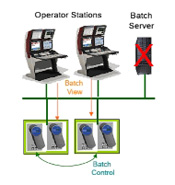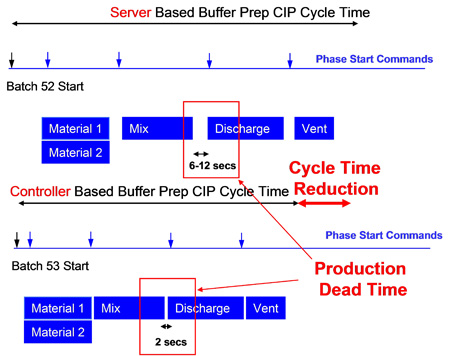Today’s competitive environment demands automation solutions that increase plant efficiency and profitability. Control system performance can have a significant impact on a plant’s bottom line. Leveraging automation capabilities through simplified, cost-effective new technology while optimising current investments is key to success.
As technology advances, legacy batch control systems can no longer meet corporate objectives that include production agility, production reliability, reporting and sharing of business information. Nor can they provide sophisticated control capabilities that enable increased throughput, lower costs and improve regulatory compliance while responding to customer demands for better product quality and faster delivery cycles.
Most batch plants face common challenges that include:
- Maximising productivity from assets in use to meet demand
- Producing an increasing number of different products
- Maintaining the complex sequencing software in batch execution often on mature control platforms
- Reducing production costs to remain competitive.
Technology now available for batch automation can help with these challenges to improve business results.
Server-based architecture: The ISA S88 standard for batch processes has been in use for some years and has provided measurable benefits for all stakeholders in the batch industry. S88 has provided a common structure and vocabulary that has been universally adopted. The first generation of S88 batch control systems rely on parts of the batch executing in a server or other high-level network node. This server becomes a communication bottleneck between the controllers that carry out the process actions and the operator.
In server-based architectures the operator’s view of the batch is provided via the batch server and server failure can lead to loss of view and loss of production. Control of phases is also reliant on the server. A server failure can lead to a hazardous situation or reduction in quality if phases cannot execute as configured when expected.
While a batch server can be nominally redundant manual intervention is still required to change over between servers. Batch processes require many peer-to-peer connections between controllers, a function that cannot be performed by the batch server. Interruptions to production are required for the server to be shut down for routine Microsoft maintenance.
Controller-based architecture: Progress in technology now allows an entire batch sequence to execute in the controller, which brings a number of business benefits over the server-based batch system. A controller-based system is inherently more robust and provides a single operating and engineering platform for batch execution. The absence of a server removes the associated costs, security and maintenance issues as well as communication latency. This plant can produce 22 different products. The batch system supports any valid route through the plant from a single recipe. This keeps maintenance of the recipes at a manageable level.

Controller-based architecture
A recipe can be considered as being in two parts: first, the procedural element of Procedure/Unit Procedure/Operation; and second, the formula values (times, temperatures and raw material quantities). The procedural elements may differ little between products. For the purposes of this example, assume products 1-18 require procedure A and products 19-22 required procedure B.
All products can be accommodated, therefore, by building and maintaining two procedures and 22 formula sets. The procedure, formula and route through the plant are selected at run time. Equipment can be selected at any point during recipe execution before the unit procedure requiring that equipment executes.
The following calculation gives an idea of the value of a controller-based system:
Cycle time reduction: Taking into account factors such as the sales value of the product and market conditions, the execution of a batch in the controller affects business results. The dead time for communication exchange between a server and controller reduces the throughput of a plant. Between each phase in batch execution there is dead time while the server and controller communicate and exchange data. This is long enough to cause process problems on fast executing batches and is unproductive time on any batch. By simply moving batch execution to the controller this dead time is reduced and productivity of a plant can be improved by up to 3% through this step alone.

A cleaning in place example. When multiple units and multiple cycles are taken into account over annual production the reduction in cleaning time (an unproductive part of the process) can increase plant throughput by 3%
The diagram above shows a cleaning-in-place example. When multiple units and multiple cycles are taken into account over annual production the reduction in cleaning time (itself an unproductive part of the process) can increase plant throughput by 3%.
Applying the same logic to API production and calculating the value with assumptions that:
- Additional production can be sold profitably
- Sale value of a batch is €5,000/tonne
- Finished batch is 1 tonne of saleable product
- Plant has two mixers which are the production bottleneck
- Average batch cycle time is 6hrs
- Plant operating days/year is 340 at 24hrs/day
- Batches/year is 340 days x 24hrs/6hrs x 2 mixers – totalling 2,720 batches
- Number of recipe steps is 70
By moving batch execution from a server to the controller:
- Controller execution reduces step delay times from 12 seconds to two seconds
- Batch cycle time is reduced to 5hrs 48mins (70 steps x 10secs)
- Batches/year is 340 days x 24hrs)/5.8hrs x 2 mixers – totalling 2814 batches (3% increase)
- 94 additional batches/year means additional revenue of €470,000
End-user experience is that the flexibility of controller-based batch execution enables many other improvements in batch cycle time, raw material usage and user productivity.
Removing server dependence for batch execution reduces disruption to business caused by server problems. An 8hr interruption to server availability can result in a loss of revenue of €30,000. Additional costs for investigation and rectification can amount to €20,000.
All batch systems require regular changes such as modifications to equipment, changes in product specification or process improvements. Experion Batch Manager requires no shutdown of any element to make any type of change. Equipment and recipe configuration can be changed online, controllers or other hardware additions take place online. First-generation server-based batch systems required a shutdown of the server and/or controller for plant configuration changes, network configuration changes and Microsoft patch installation.
By building batch into the system, Experion Batch Manager reduces the skill level required to support these routine changes. The same engineering tools and user environments handle all DCS configuration, maintenance and operational functions. This means that readily available site resources can maintain the whole system.
Typical annual savings for an API plant are:
-
Reduced support costs for server and batch application: €20,000
Reduced training costs: €13,000
Benefits from timely process improvements vs waiting for shutdown window: €25,000
Lost production/other costs from server problems avoided through controller execution: €40,000
Total annual savings: €98,000
In summary, controller-based architecture uses current technology to overcome problems experienced with batch solutions from the past by building batch into the system. Honeywell’s Experion Batch Manager is designed to maximise the availability, productivity, operability and maintainability of any batch plant to improve plant efficiency and profitability.
